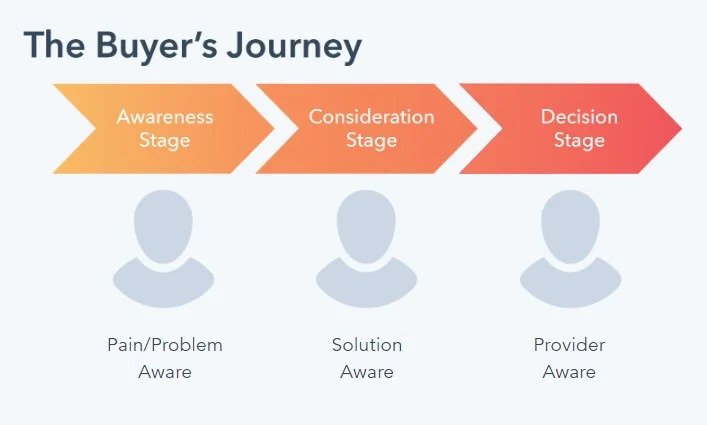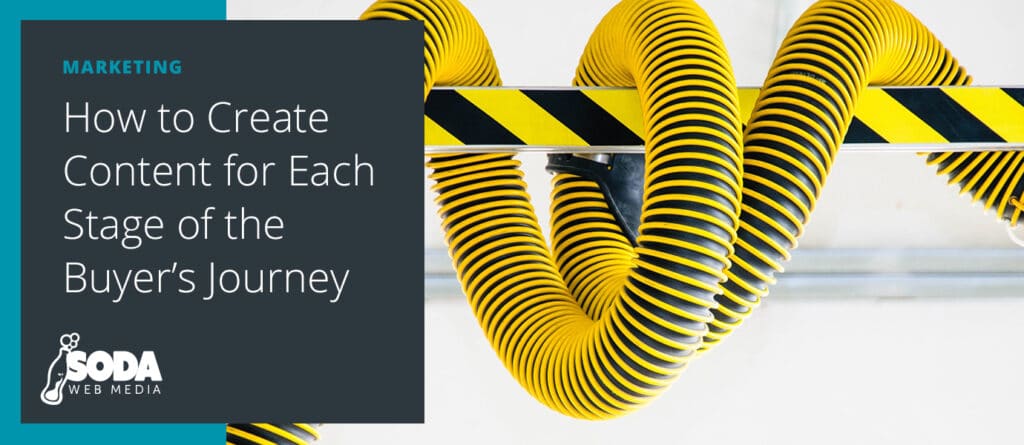One of the biggest mistakes that businesses make when developing a content program is treating all prospective buyers the same. As a result, many brands end up unknowingly focusing all their efforts on one type of buyer, leaving large swaths of the market either untouched or unengaged.
The reality is that there is no one singular type of buyer. Every visitor to your site is bringing their own level of background knowledge, purchase intent, and preconceived notions to the table. Your job as a content marketer is to serve up content that addresses and alleviates all these visitors’ diverse needs, questions, and concerns.
Think of it like this: if you’re planning to purchase a bottle of laundry detergent, you probably already have a go-to brand. But if you want to buy your first lawnmower, you might have absolutely no idea where to even start looking. If a lawnmower brand treated you as a regular customer and a detergent brand served you content directed for first-time launderers, neither of them would stick very well.
In this guide, we’re going to help you identify and fix these potential oversights in your content. We’ll cover the different stages of the buyer’s journey, the types of content that work for each of them, and finally, how to make sure your brand is using content effectively.
What Is the Buyer’s Journey?
The buyer’s journey is the path that buyers traverse before making a purchase. For the most part, buyers progress from an awareness stage to a consideration stage and, finally, to a decision stage. Visually, it looks something like this:

The Awareness Stage
In the first stage, a prospective buyer only knows that there is a pain or a problem that needs to be solved. For example, a buyer may be starting their first business and realize that they need an email marketing platform or another type of marketing tool.
At this point, the buyer may not know any potential solutions — they just know they have a problem. In an effort to find a solution, they may Google terms like “best email marketing tool” or “email marketing for small business.”
And that’s where you come in. As a marketer, your goal is to catch buyers in this stage of the journey and make them aware of your product. The point isn’t to sell to them immediately but to let them know your brand can help.
Awareness stage content typically includes blog posts, social media content, whitepapers, ebooks, and webinars.
The Consideration Stage
Once a buyer is aware of the solutions available to them, they move into the consideration stage. As the name implies, this point in the buyer’s journey is characterized by the careful consideration of several different options.
Following our previous example, by now a buyer will already know about a few different email marketing tools. However, they will want more specific information about how different solutions compare to each other: what makes one tool better than another? What are the advantages of using Mailchimp instead of Klaviyo?
To engage this type of buyer, brands need to serve up content that explains why their solution is the right choice. To do this, you can either create content that speaks to the benefits of your product or compares it to competitors. This usually takes the form of case studies, free samples, and product comparison guides.
The Decision Stage
Eventually, a buyer will settle on a preferred option. The only thing left is to close the sale by allaying any remaining doubts, concerns, or objections.
Generally, this means offering a free trial, a coupon, a live demo, or a free consultation. For example, a buyer at this stage will want to try out Mailchimp for 30 days and see if it’s really working for them. Alternatively, they might want to get on the phone with a sales rep to discuss any concerns that weren’t covered in the previous stages’ content.
Why the Buyer’s Journey Matters
When your content doesn’t address each of these stages, you’ll lose out on customers either because they dropped off towards the end of the funnel or because they never found out about your product in the first place.
For example, if you run an email marketing tool brand and don’t post any awareness stage content, your competitors who have good early-stage content will take customers away from you. If you have solid awareness stage content but don’t provide any case studies or product comparison guides, you’re going to hand over business to other providers that can make a more compelling argument to buyers in the consideration stage.
An effective content marketing strategy will gracefully guide a buyer straight from the awareness stage to the decision stage without any gaps. If it doesn’t, then you need to rethink your strategy.
How to Create Content for Each Stage of the Buyer’s Journey
Now that you have a clear idea of what the buyer’s journey entails, here are some actionable steps you can take to ensure your content hits all the right spots.
Awareness Stage Content
Awareness stage content includes a blog and social media posts, videos, webinars, tools, kits, whitepapers, and ebooks. The key to crafting killer content for this buyer stage is ensuring that your creatives are educational and informative without being too focused on your product alone.
For example, awareness stage content for an email marketing tool might include a blog post on how segmenting your email list can increase conversions. The piece might mention the specific tool and even use it throughout the tutorial, but it’s not the focus. Instead, the goal of the post is to offer some valuable educational content while inconspicuously making the audience aware that the tool exists.
To get a bit meta, you’re reading a piece of awareness stage content right now (guess we’re not doing so well on the inconspicuous part). This post isn’t specifically about our services, but if you learn something new, maybe you’ll check out what we can do for you down the road. Just a suggestion.
Consideration Stage Content
Content for the consideration stage generally focuses on case studies and product comparison guides.
Case studies are useful because they give concrete examples of what a product or service can do for a customer. They move the information from the theoretical and abstract into the realistic and practical: has this product actually benefited other customers? What sort of results have other customers received?
Product comparison guides don’t cleanly fit into one stage. Typically, they will put specific products head to head and evaluate how they stack up in terms of cost, features, customer service, etc. In these cases, they fall more in line with the consideration and decision stages.
However, some guides take a more general approach, comparing general product categories instead of individual solutions. This type of guide fits more into the awareness stage.
Decision Stage Content
Successful content at this stage generally needs to make use of interactivity. When a buyer reaches the decision stage, they need information about their unique and personalized concerns. Overall, you can think of content becoming more and more specific as it moves through the buyer’s journey.
At this stage, brands can offer free trials, live demos, consultations, or coupons, all of which break down the barriers to entry and allow buyers to explore their specific concerns.
Auditing Your Content
If your business is just starting its content program, then you can use this guide as a roadmap. But if you’re already knee-deep in content, take this as an opportunity to see whether you’re on the right track or if there are large gaps in your content.
Thankfully, performing a basic content audit in the context of this guide is fairly simple. To start, go through your content and make note of how much speaks to each of the different buyer stages. If one stage seems disproportionately larger or smaller without a good reason behind it, you can focus your efforts on beefing up that portion of your content.
The Bottom Line
A successful content program is a diversified one. If your content isn’t comprehensively addressing buyers’ needs in all the different stages of their journey, you will inevitably lose out on revenue. If you put this guide to use, you can attack your content head-on and ensure it speaks to buyers of all types.

